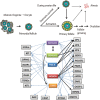Transcription factors in the maintenance and survival of primordial follicles
- PMID: 23346521
- PMCID: PMC3548069
- DOI: 10.5653/cerm.2012.39.4.127
Transcription factors in the maintenance and survival of primordial follicles
Abstract
Primordial follicles are formed prenatally in mammalian ovaries, and at birth they are fated to be activated to primary follicles, to be dormant, or to die. During the early stage of folliclulogenesis, the oocyte undergoes dynamic alterations in expression of numerous genes, which are regulated by transcription factors. Several germ-cell specific transcriptional regulators are critical for formation and maintenance of follicles. These transcriptional regulators include: Figla, Lhx8, Nobox, Sohlh1, and Sohlh2. A subset of these transcriptional regulators is mutated in women with ovarian insufficiency and infertility. Establishment of this oocyte pool is essential for fertility. This review focuses on these transcriptional regulators of female primordial follicles.
Keywords: Figla; Lhx8; Nobox; Primordial follicles; Sohlh1; Sohlh2; Transcription factors.
Conflict of interest statement
No potential conflict of interest relevant to this article was reported.
Figures

References
-
- McKAY DG, Hertig AT, Adams EC, Danziger S. Histochemical observations on the germ cells of human embryos. Anat Rec. 1953;117:201–219. - PubMed
-
- Baker TG. A quantitative and cytological study of germ cells in human ovaries. Proc R Soc Lond B Biol Sci. 1963;158:417–433. - PubMed
-
- McGee EA, Hsueh AJ. Initial and cyclic recruitment of ovarian follicles. Endocr Rev. 2000;21:200–214. - PubMed
-
- Oktem O, Urman B. Understanding follicle growth in vivo. Hum Reprod. 2010;25:2944–2954. - PubMed
LinkOut - more resources
Full Text Sources

